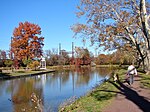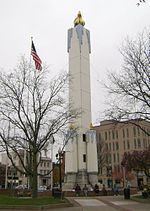Jacob Mixsell House
Federal architecture in PennsylvaniaHistoric House Museums of the Pennsylvania GermansHistoric house museums in PennsylvaniaHouses completed in 1833Houses in Northampton County, Pennsylvania ... and 4 more
Houses on the National Register of Historic Places in PennsylvaniaIndividually listed contributing properties to historic districts on the National Register in PennsylvaniaMuseums in Northampton County, PennsylvaniaNational Register of Historic Places in Northampton County, Pennsylvania

The Jacob Mixsell House, also known as the Northampton County Historical and Genealogical Society, is an historic American home that is located in Easton, Northampton County, Pennsylvania. It was added to the National Register of Historic Places in 1980.
Excerpt from the Wikipedia article Jacob Mixsell House (License: CC BY-SA 3.0, Authors, Images).Jacob Mixsell House
Saint John Street, Easton
Geographical coordinates (GPS) Address Nearby Places Show on map
Geographical coordinates (GPS)
| Latitude | Longitude |
|---|---|
| N 40.680555555556 ° | E -75.210277777778 ° |
Address
Saint John Street 398
18042 Easton
Pennsylvania, United States
Open on Google Maps










